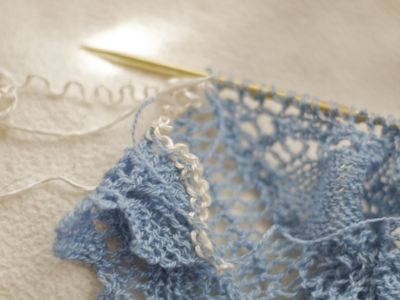This post is a bit of a departure for me. Yes, it is about knitting. You cast on when you put stitches on your needle to begin a piece of knitting. A provisional cast on is a method of leaving stitches “live” so that after knitting “up” from them in the normal way, you can start again at the bottom and knit “down” from the stitches you cast on. There are some good reasons for needing a provisional cast on: adding a collar or a hem, grafting a border or building out from the middle on a lace project. There are also some bad reasons (in my mind) like using them everywhere because you have a pathological fear of seaming. Anyway, I am working on one such seamless pattern now and have had a little, shall we say, provisional cast on drama, so I am writing this post more as a memory aid to myself, because there are a numbers of methods out there and some are better than others.
There is this one, from Knitty and the Yarn Harlot. Like all provisional cast ons it involves waste yarn. The waste and actual yarn are twisted around each other and then the actual yarn gets twisted around the needle. It isn’t bad, and I have used it on a lace project that I am working on now. All that twisting can be cumbersome, and the stitches can be loose and even, which is why I think it is better for lace. Interestingly enough, it does not look like it is the provisional cast on the Yarn Harlot has used herself here:

That looks like it might be a crochet cast on, which is my favourite. There are a couple of ways of doing it. Techknitter suggests that you crochet a chain and then pick up stitches in the bumps. It works but it is a little bit cumbersome — it is telling that techknitter’s preferred way of doing a provisional cast on is by simply knitting for a few rows in waste yarn, beginning with the actual yarn and then, when you need the live stitches, just snipping the wast yarn and unravelling it (That actually may be what the Yarn Harlot has done in the photo above). I think the easiest crochet provisional cast on is the method described by Woolly Wormhead (yes, the names are great, aren’t they?). Instead of making a chain and then picking up stitches from the back bumps, you turn the back bumps into stitches by cricheting the chain right onto your needle. It means you can used a crochet hook that is closer in size to your needle and waste yarn that is closer to your actual yarn, meaning that the provisional stitches will be less noticeable once you come to use them. You can quickly and easily unzip the crochet chain once you are read for the live stitches.
Which brings me to the last provisional cast on, one I do not recommend, from Wendy Bernard. It begins with a long tail cast on done with actual yarn (forming the loops of the stitches) and waste yarn as the second yarn. It has the benefit that the set up is really easy while all of the other options have a set up that is more time consuming and cumbersome. The problems emerge when you are ready to use the provisional stitches. After I unpicked the waste yarn from the bottom and began knitting, I found my whole row of 2×2 ribbing was askew. I am not sure what I could have done to fix it — when I pulled out the needle, I found that none of the stitches were truly “live.” It may be that I do my long tail cast on in a different way than others do. BUT even if the long tail cast on worked as promised, I would still not recommend this method because of the tiresome unpicking of each bit of waste yarn that is necessary. Each stitch must be picked out one by one with a needle, and you have to keep snipping off the end of the waste yarn or it gets to difficult to pull it through. All this wok to avoid seaming two inches of shoulder straps. So not worth it.
